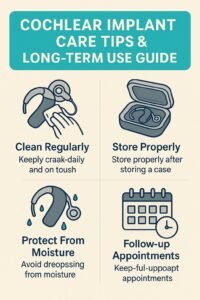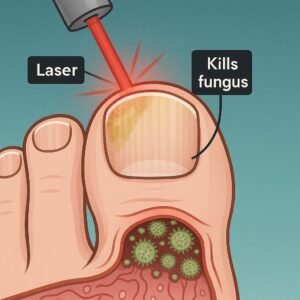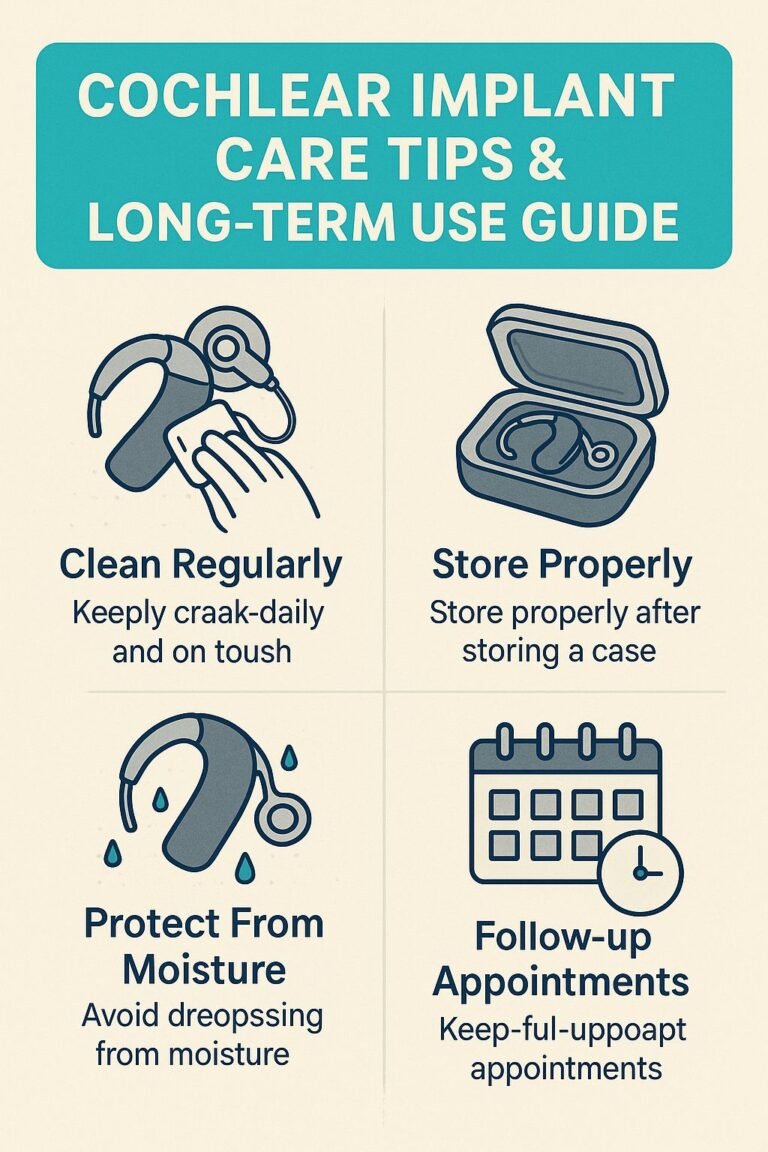Key Points
- Tea tree oil is a natural antifungal solution that can be applied directly to the infected toenail.
- Baking soda can be used as a paste on toenails to help prevent the growth of fungus.
- Over-the-counter treatments such as antifungal creams can be effective but may take several months.
- Laser treatments are another option but can be expensive and may not be covered by insurance.
- Good foot hygiene and breathable shoes are important for preventing toenail fungus.
Understanding the Best Toenail Fungus Treatments & Remedies
Toenail fungus can be annoying and embarrassing to deal with. The medical term for this condition is onychomycosis, and it often causes the nails to become discolored, thick, and brittle. Luckily, there are many different treatments available, from natural remedies to medical treatments. Understanding these options can help you decide what the best course of action is for you.
The Best Quick Fixes
There are some treatments that are known for their speed when it comes to toenail fungus. Natural treatments like tea tree oil and baking soda are often chosen for their convenience and simplicity. Over-the-counter antifungal treatments are also an easy choice, although they might require a bit of patience.
It’s crucial to remember that regularity is the name of the game when it comes to these treatments. Regardless of whether you opt for a natural remedy or an over-the-counter product, the more frequently you apply the treatment, the more effective it will be. Laser treatments are a contemporary alternative for those looking for a faster solution, but they have their own set of considerations.
What Affects the Success of Toenail Fungus Treatment?
There are a few things that can affect how well toenail fungus treatment works. The worse the infection, the harder it is to treat. The kind of fungus and your general health can also affect how well the treatment works.
In addition to that, personal habits such as foot hygiene and choice of footwear can either help or hurt recovery. Keeping feet dry and wearing breathable shoes can prevent the fungus from thriving. Lastly, patience is key, as toenail fungus often requires a long treatment to see visible results.
What Causes Toenail Fungus and What Are Its Symptoms?
Knowing what causes toenail fungus and how to recognize its symptoms is key to preventing and treating it. Fungi love warm, damp places, so feet can easily become a breeding ground if not looked after.
Signs can be different, but they frequently consist of changes in color, thickness, and the nail breaking down. The infection might begin as a white or yellow spot under the edge of the toenail and get worse over time. If you’re seeking a holistic approach, exploring somatic healing techniques might be beneficial.
Usual Suspects
Usual suspects of toenail fungus include exposure to moist environments, like public showers and swimming pools. Wearing snug shoes or socks that don’t allow your feet to breathe can also add to the growth of fungus.
Moreover, any damage to the nail or skin around it can become a gateway for the fungus. Individuals with compromised immune systems or health conditions such as diabetes are more susceptible to toenail fungus.
Identifying the Signs
Early identification of toenail fungus symptoms can result in a more successful treatment. Be on the lookout for indicators like a shift in the color of your nail, a deformation of the nail shape, and a nasty smell coming from the nail region. For more information on symptoms and treatment management strategies, consider exploring related health topics.
In certain situations, the nail might lift from the nail bed, which can be uncomfortable or painful. If you see any of these signs, it’s a good idea to start treatment as soon as possible to stop the condition from getting worse.
Progression of Toenail Fungus
If left untreated, toenail fungus can worsen over time. At first, you may see a small discolored area or spot under the nail. As the fungus continues to grow, the nail may become thicker, brittle, and change color.
If left untreated, the nail can become brittle and may even separate from the nail bed. It’s best to tackle the fungus early to avoid these complications and make the treatment process easier.
Store-Bought Remedies
For those who want a quick and easy solution, store-bought treatments are the way to go. You can usually find these treatments in the form of creams, ointments, or nail polishes that are made specifically to fight off toenail fungus.
Over-the-Counter Solutions That Work
There are many over-the-counter treatments that can help, each with different active ingredients. Try to find products that contain terbinafine, clotrimazole, or undecylenic acid, as these are known to be effective against fungal infections.
It’s important to use these treatments as instructed. You’ll likely need to use them consistently over several months to get the results you want, as toenail fungus can be tough and slow to treat.
How to Use Over-the-Counter Treatments
Here are some tips to make the most of over-the-counter treatments: consider exploring somatic healing techniques as complementary practices.
- Ensure the infected area is clean and dry before application.
- Apply the remedy directly to the nail and skin around it.
- Let the treatment dry completely before wearing socks or shoes.
- Be consistent and patient, as it may take time for results to show.
Getting to Know the Duration of Treatment
It is important to understand the expected duration of treatment to set the right expectations. Most over-the-counter treatments require application for several weeks to months. This length of time allows the product to penetrate the nail and effectively fight the fungus.
Even if you start to see improvement, don’t stop the treatment. If you do, the fungus could come back. Make sure to finish the entire course of treatment to completely get rid of the fungus. If you’re interested in understanding more about how treatments work on a physiological level, you might want to explore somatic healing and its benefits.
Tea Tree Oil: A Powerful Fungus Fighter
Tea tree oil, which comes from the leaves of the Melaleuca alternifolia tree, is known for its strong antifungal and antiseptic properties. This makes it a great natural remedy for toenail fungus. To use it, simply dip a cotton swab in the oil and apply it to the affected nail and the skin around it. For the best results, do this twice a day. Just be aware that tea tree oil is very strong, so you should do a patch test on your skin before you start using it regularly to make sure it won’t irritate your skin. For more home remedies for toenail fungus, you can explore other options available.
Using Baking Soda to Stop Fungal Growth
Did you know that you can use baking soda to combat toenail fungus? Baking soda is alkaline, which means it can create an environment where fungus can’t survive. To use it, mix it with water to make a paste and apply it directly to your toenails. For more information on home remedies for toenail fungus, check out this helpful guide.
Keep the paste on for around 10 to 15 minutes before washing it off with warm water. You can also sprinkle some baking soda inside your shoes to absorb any moisture and reduce the growth of fungus for a more effective result. For additional tips on maintaining foot health, consider exploring these expert-recommended fitness products that can complement your routine.
Let’s take Sarah as an example. She’s a runner and she tried applying a paste made from baking soda on her toenails on a regular basis. Just a few weeks later, she saw a big improvement in the health of her nails.
It is important to apply this treatment every day until you see improvement.
Vicks VapoRub: An Unexpected Solution
Did you know that Vicks VapoRub, a popular remedy for coughs, also has antifungal properties? Thanks to ingredients like camphor and eucalyptus oil, a daily application of a small amount of Vicks VapoRub to the infected toenail can help combat the fungus.
Advantages of Ozonized Sunflower Oil
Ozonized sunflower oil is a natural alternative that has demonstrated potential for toenail fungus treatment. The oil is saturated with ozone, which increases its fungicidal properties. To use, put a few drops on the infected area twice daily. For more on natural health solutions, explore these asanas to relieve lower back pain.
For those who favor a more gentle approach, this treatment is ideal, as it’s known to be less irritating than other topical treatments.
When Should You Use Vinegar?
Vinegar, particularly apple cider vinegar, is a common household remedy for toenail fungus because of its acidity. It creates conditions that prevent the growth of fungus. To use vinegar, you should immerse your feet in a solution of vinegar and water in equal proportions for 15-20 minutes every day.
Vinegar can be a good solution, but it may take longer to see results compared to other treatments. It’s best to use it along with other remedies for a complete treatment plan, such as incorporating somatic healing techniques.
Prescription Remedies
If your toenail fungus is particularly bad, you may need a prescription remedy. These remedies typically involve more potent medications that need to be monitored by a healthcare professional. While they can be more effective, they can also have side effects.
Pills That Fight Fungus
Doctors often prescribe pills like terbinafine and itraconazole to treat toenail fungus. These pills go to work internally, attacking the fungus through your bloodstream. You’ll usually take these medications for 6-12 weeks, but you might not see the end of the infection for several months.
Prescription Topical Treatments
Prescription topical treatments include creams and medicated nail polishes that are applied directly to the nail and the skin around it. While they may take longer to show results than oral medications, they are often a safer choice for those who cannot take oral antifungal medicines.
Topical prescriptions such as ciclopirox and efinaconazole are proven to be effective against fungal infections.
Keeping an Eye Out for Side Effects
When taking prescription treatments, you should always be mindful of potential side effects. For instance, oral antifungals can potentially harm your liver, so you may need to get regular blood tests to make sure your liver is functioning properly. Topical treatments usually have less side effects, but they can still cause irritation at the site of application.
It’s crucial to talk to a healthcare provider to make sure the treatment you pick is safe and right for your unique situation. For those interested in alternative approaches, exploring somatic healing might offer additional insights.
Non-Traditional Remedies
For those who are not interested in conventional or home remedies, there are other solutions. These treatments can be beneficial, but it’s crucial to weigh the costs and possible side effects.
The Advantages of Laser Treatment
Laser treatment is a contemporary solution to toenail fungus that uses targeted light to kill fungal cells. This non-invasive method can be successful in lessening fungal infection. However, it usually necessitates numerous appointments and can be costly.
Downsides and Dangers of Surgery
For extreme cases where other methods haven’t worked, you might consider having the nail surgically removed. This method can successfully get rid of the infection, but it’s not without its drawbacks, like pain, the possibility of infection, and a lengthy recovery period.
Usually, surgery is only considered when the nail is causing a great deal of discomfort or when other treatments have proven ineffective.
Preventative Measures
It’s just as crucial to prevent toenail fungus as it is to treat it. You can lower your chances of getting an infection and keep your nails in good health by following certain habits, similar to how wellness retreats promote overall health and well-being.
Keeping your feet clean and dry, trimming your nails regularly, and avoiding walking barefoot in public areas like pools and locker rooms is the first step to preventing toenail fungus.
Opting for shoes that allow your feet to breathe and socks made from natural materials can help keep your feet dry and less likely to attract fungus.
Maintaining Good Foot Hygiene
It’s very important to maintain good foot hygiene to prevent toenail fungus. You should wash your feet every day with soap and water and make sure to dry them thoroughly, especially in between your toes. Fungi thrive in moist environments, so it’s very important to keep your feet dry. You should also change your socks often and choose socks that wick away moisture to keep sweat from accumulating.
Pick Shoes That Let Your Feet Breathe
Footwear can play a big role in preventing toenail fungus. Shoes made of natural materials, like leather or canvas, are better at wicking away moisture. Try not to wear the same pair of shoes every day so they have time to dry out. And if you use public showers or pools, wear flip flops or other protective shoes to keep your feet from touching surfaces that could be covered in fungus.
Proper Nail Maintenance
Another important method to prevent toenail fungus is proper nail maintenance. Cut your nails straight across and keep them short to lessen the chance of injury and infection. Always use clean, sterilized nail clippers, and never share them with others to prevent the spread of infection. If you get your nails done at a salon, make sure they have strict sanitation procedures.
Final Thoughts: Picking the Best Treatment
When it comes to picking the best treatment for toenail fungus, it’s important to consider the severity of your infection and the various options at your disposal. Whether you choose to use natural remedies, over-the-counter products, or prescription treatments, the most important thing is to be consistent and patient. After all, toenail fungus can be stubborn and it often takes time before you start seeing visible results.
Alongside addressing the infection, taking preventative steps can aid in keeping your nails healthy and avoiding future infections. By merging treatment with good foot hygiene and lifestyle changes, you can effectively control and conquer toenail fungus.
Choosing the Right Treatment
When choosing the right treatment, it’s important to take into account how severe your infection is, your previous health history, and what you personally prefer. Natural remedies and over-the-counter treatments can work well for milder cases. However, if your infection is severe or keeps coming back, you might need to see a healthcare professional to get a prescription.
Talking to Your Doctor
It’s important to speak to your doctor if you have symptoms that don’t go away or get worse. They can diagnose you and give you the right treatment plan for your specific condition. Sometimes, you may need more than one treatment to get the best results.
Commonly Asked Questions
We’ve compiled a list of frequently asked questions about toenail fungus to help you understand more about this condition and the available treatments.
What is the quickest way to get rid of toenail fungus?
The quickest way to get rid of toenail fungus usually involves a combination of oral antifungal drugs and topical treatments. However, these should be prescribed by a doctor. Laser treatments can also offer faster results but may not be suitable for everyone.
Do home remedies work for toenail fungus?
Home remedies can work for mild toenail fungus if used consistently. Tea tree oil, baking soda, and vinegar are common choices. But for more serious infections, you may need professional medical treatment.
Home remedies often require a consistent and patient approach as they may take some time to produce noticeable results.
When should I consult a doctor for toenail fungus?
You should consult a doctor if the infection is severe, causing discomfort, or if home treatments have not worked after a few months. Also, if you have underlying health issues like diabetes, it’s important to get medical advice immediately.
Will toenail fungus disappear by itself?
It’s unlikely that toenail fungus will disappear without treatment. If left untreated, it can cause more serious problems. It’s best to start treatment immediately.
First and foremost, treating toenail fungus at the onset can prevent it from worsening and make the treatment process easier.
Can toenail fungus be passed from person to person?
Indeed, toenail fungus can be transmitted from one person to another. It can be spread through direct contact or through the use of personal items such as nail clippers or shoes. Maintaining good hygiene and not sharing personal items can help prevent the spread of the fungus.










